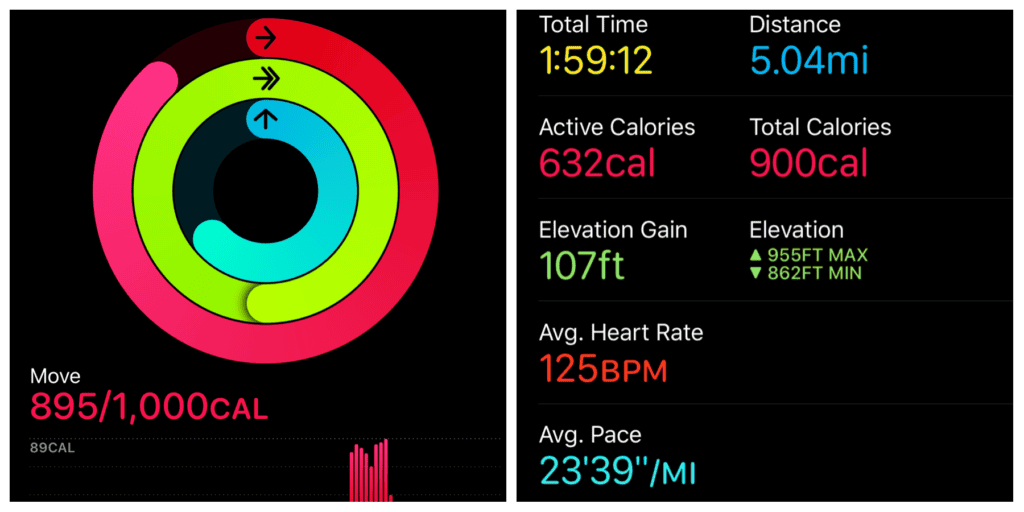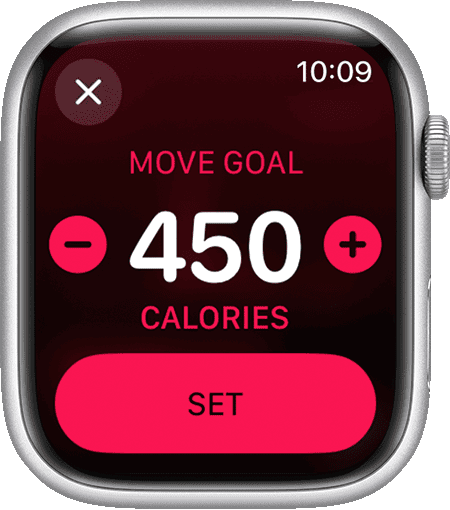Do you want to keep track of the calories you’re burning with your Apple Watch? Whether you’re working out or just going about your day, your watch is constantly recording your calorie burn. Let’s go through how to access and interpret this data so that you can get the most out of your fitness journey. When using an Apple Watch to monitor your fitness and health, one of the important measurements you’ll come across is “Total Calories.” It’s crucial to understand what this number means, especially if you’re using your Apple Watch to track your fitness progress or manage your weight.
Tracking Your Burn: Understanding Calorie Counts on Your Apple Watch
Active vs Total Calories
Your Apple Watch tracks two types of calories:
- Active Calories: These are the calories you burn through exercise or intentional movement.
- Total Calories: This includes active calories plus your basal metabolic rate (BMR), which is the energy your body uses just to function at rest.
Where to Find Your Calorie Data
You can view your calorie information in a few places:
- Activity app on your watch: Check your daily progress rings or tap on a specific workout to see calorie details.
- Fitness app on your iPhone: Get a more detailed breakdown of your calorie burn over time.
- Health app on your iPhone: See your calorie data alongside other health metrics.
Factors Affecting Calorie Estimates
Your Apple Watch uses various factors to estimate your calorie burn, including:
- Heart rate: A higher heart rate generally indicates more intense activity and greater calorie expenditure.
- Movement: The built-in accelerometer tracks your movement to gauge the intensity of your activity.
- Personal information: Your age, gender, height, and weight help personalize the calorie calculations.
Accuracy and Limitations
While Apple Watch strives for accuracy, it’s important to remember these are estimates.
- Individual variations: Everyone’s metabolism and calorie burn are slightly different.
- Activity type: The watch may be more accurate for certain activities than others.
- Wrist fit: A loose fit can affect heart rate readings and calorie estimates.
Tips for Using Calorie Data
Here are some tips to get the most out of your Apple Watch’s calorie tracking:
- Set realistic goals: Use the data to track your progress and make adjustments as needed.
- Focus on trends: Don’t get hung up on daily fluctuations; look at your overall progress over time.
- Combine with other health metrics: Consider your calorie data alongside your heart rate, sleep, and other health information for a holistic view of your well-being.
Apple Watch & Your Caloric Burn
Your Apple Watch is a fantastic fitness companion, but it can be a bit confusing when it comes to tracking calories. It’s important to understand the distinction between active and total calories to accurately track your energy expenditure.

Active vs. Total Calories: What’s the Difference?
- Active Calories: These are the calories you burn through intentional exercise, like workouts, brisk walks, or runs. Your Apple Watch tracks these calories using its heart rate sensor and motion data. You can see your active calories in the red “Move” ring on the Activity app.
- Total Calories: This encompasses all the calories you burn throughout the day, including both active calories from exercise and passive calories from your basal metabolic rate (BMR). BMR represents the calories your body burns at rest to maintain essential functions like breathing and digestion.
How to See Your Total Calories
While the Apple Watch doesn’t directly display total calories, you can easily find them in the Fitness app on your paired iPhone:
- Open the Fitness app on your iPhone.
- Tap on the Activity rings.
- Look for the “Total” section, usually located below the Move ring.
This “Total” number represents your overall caloric burn for the day, combining both active and passive calories.
Why Total Calories Matter
Understanding your total calorie expenditure is crucial for weight management and achieving fitness goals. It gives you a complete picture of your daily energy needs and helps you make informed decisions about your diet and exercise routines.
| Goal | Focus On |
|---|---|
| Weight Loss | Total calories burned should exceed calories consumed to create a calorie deficit. |
| Weight Gain | Total calories consumed should exceed calories burned to create a calorie surplus. |
| Maintenance | Aim for a balance between calories consumed and calories burned. |
By tracking both active and total calories with your Apple Watch and iPhone, you can gain valuable insights into your overall health and fitness journey.
What are Total Calories on Apple Watch?
Total calories on the Apple Watch represent the sum of all calories you’ve burned in a given period. This includes two main types of calories:
- Active Calories: These are calories burned during periods of physical activity. Whether you’re working out, going for a run, or simply moving around, your Apple Watch tracks these calories. Active calories are a measure of the extra effort you put in beyond your body’s resting state.
- Resting Calories: In contrast to active calories, resting calories are those that your body burns naturally, even when you’re not actively moving. These are the calories your body uses for basic functions like breathing, circulating blood, and cell production.
The formula to understand this is quite straightforward: Total Calories = Active Calories + Resting Calories. This means that your total calorie count includes both the energy expended during physical activities and the energy used for basic bodily functions.
How Does the Apple Watch Calculate These Calories?
Your Apple Watch uses various sensors and data points to calculate both active and total calories. For active calories, it considers your movement and exercise data. The watch uses your heart rate, the intensity of your movements, and the duration of your activity to estimate the number of active calories burned.
For total calories, the watch also takes into account your Basal Metabolic Rate (BMR). BMR is the number of calories your body needs to perform basic life-sustaining functions. The Apple Watch calculates your BMR based on personal data such as your height, weight, age, and gender. The formula used by the Apple Watch is: Active Calories = Total Calories – BMR. This means that to get your total calorie count, your watch adds your active calories to the estimated number of calories you burn by just existing.
Why is Understanding Total Calories Important?

Understanding the concept of total calories is crucial for several reasons:
- Weight Management: If you’re trying to lose, gain, or maintain weight, knowing your total calorie burn can help you manage your diet more effectively. By understanding how many calories you burn in a day, you can adjust your calorie intake accordingly.
- Fitness Goals: For those with specific fitness goals, monitoring both active and total calories can provide valuable insights. For example, if your goal is to increase endurance or strength, focusing on active calories can help measure the intensity of your workouts.
- Overall Health Monitoring: Total calorie count is also a useful metric for general health monitoring. It gives you an idea of how active you are in a day and whether you need to increase your activity levels for better health.
FAQs
What does the total calories on the Apple Watch mean?
The total calories on your Apple Watch represents the combined amount of calories you’ve burned through both active movement (exercise, walking, etc.) and your basal metabolic rate (BMR), which is the energy your body uses at rest for basic functions like breathing and digestion.
Should I count active or total calories?
It depends on your goals. If you’re primarily interested in tracking the calories burned through exercise, focus on active calories. However, if you’re aiming for overall calorie awareness or weight management, total calories provide a more comprehensive picture of your energy expenditure.
How accurate are the calorie measurements on Apple Watch?
Apple Watch utilizes heart rate, movement data, and personal information like age, gender, height, and weight to estimate calorie burn. While it strives for accuracy, these are still estimations. Factors like individual variations in metabolism, activity type, and even how snugly the watch fits your wrist can influence the accuracy.
What’s the difference between total calories and move calories on Apple Watch?
Move calories on your Apple Watch are the same as active calories – the calories you burn through intentional movement and exercise. Total calories, on the other hand, encompass both move calories and your basal metabolic rate (the calories your body burns at rest).
Can I see both active and total calories on my Apple Watch?
Yes, you can view both active and total calories on your Apple Watch. The Activity app on your watch displays your daily progress rings, including one for Move (active calories). For a more detailed breakdown, you can check the Fitness or Health app on your paired iPhone.
Does the Apple Watch adjust calorie calculations based on personal data?
Absolutely! The Apple Watch uses your personal information, such as age, gender, height, and weight, to personalize calorie calculations. It’s crucial to keep this information updated in the Health app on your iPhone for the most accurate estimations.
How does the Apple Watch track resting calories?
Your Apple Watch estimates resting calories (BMR) based on your personal information and heart rate data. It takes into account your body’s energy expenditure even when you’re not actively moving, providing a more complete picture of your total calorie burn.
Is it possible to set calorie burn goals on the Apple Watch?
Yes, you can set daily Move goals (active calorie goals) on your Apple Watch. To do so, open the Activity app on your watch, scroll down, and tap on “Change Goals.” You can then adjust your Move goal to a desired calorie target.
Do I need to manually start tracking for calorie counting on Apple Watch?
No, your Apple Watch automatically tracks your calories throughout the day, whether you’re working out or simply going about your daily routine. There’s no need to manually start or stop tracking for calorie counting.
Can the calorie count help in weight loss?
Yes, monitoring your calorie burn on your Apple Watch can be a helpful tool for weight loss. It provides valuable insights into your energy expenditure, allowing you to make informed decisions about your diet and exercise routine. Remember that weight loss ultimately comes down to creating a calorie deficit, so tracking your burn alongside your intake can be beneficial.
Does the Apple Watch calorie count include calories burned during sleep?
Yes, the total calorie count on your Apple Watch includes an estimate of the calories your body burns during sleep. While you’re resting, your body still requires energy for essential functions, and this is factored into the total calorie count.
How often should I check my calorie burn on Apple Watch?
It’s up to you and your goals. Some people find it motivating to check their progress throughout the day, while others prefer to review their calorie data at the end of the day or week. The key is to use the information to stay informed and make adjustments to your lifestyle as needed.







